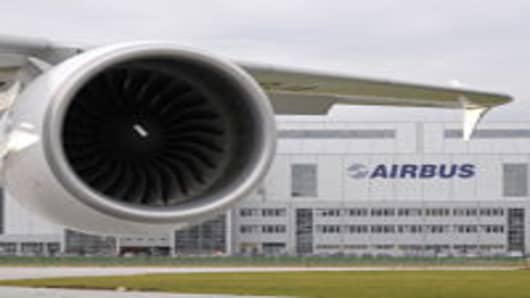European air safety officials extended checks for Airbus A380 wing cracks to the entire superjumbo fleet on Wednesday and said the widespread defects could pose a safety risk if left unremedied.
The move to inspect all 68 A380s in service came as Qantas Airways grounded one of its planes for up to a week following the discovery of 36 separate cracks in wing parts.
The new measures by the European Air Safety Agency (EASA) "reflect the results of a first round of checks, which found cracks in almost all of the planes inspected," spokesman Dominique Fouda said.
"This condition, if not detected and corrected, may lead to a reduction of the structural integrity of the aeroplane," the EU agency said in its directive to airlines.
By signaling that the flaws are thought to be structural and widespread, the fleet-wide inspection order will refocus attention on faults recently found in flagship jets from both of the world's dominant aircraft makers.
Boeing and Airbus, a division of European Aeronautic Defence & Space , maintain that their newest planes are safe to fly after problems were caught at an early stage.
Under the new directive, first reported by Reuters earlier on Wednesday, the seven airlines currently operating A380s must carry out Airbus-sanctioned checks and preliminary repairs on every plane before its 1,300th flight.
The first round of inspections, which covered one third of the fleet, applied only to jets that had exceeded that number of flights. Aircraft already approaching or beyond the threshold must now be checked and repaired within weeks.
The damaged L-shaped parts, which fix the wing skins to their underlying frame, are "not a primary load-bearing structure," Airbus spokesman Stefan Schaffrath said.
Cracks have been discovered in a "handful" of the 4,000 such brackets on each aircraft, he added. "The safe operation of this aircraft is not at stake."
Inspections had initially focused on 20 aircraft operated by Singapore Airlines , Air France and Dubai's Emirates — which had logged the most A380 flights in the four years since the world's largest passenger plane entered service.
They will now be also be carried out on superjumbos flown by Qantas, China Southern , Korean Air and Lufthansa.
Qantas grounded one of its 12 A380s after the discovery of two-centimetre (0.8 inch) cracks that were "traced back to a manufacturing issue", the Australian carrier said on Wednesday.
It was during lengthy repairs to another Qantas plane that the A380 problems first surfaced, following a 2010 engine explosion that tore open one wing.
Lufthansa's longest-serving A380 has made about 900 flights, company spokesman Michael Lamberty said. "That means we have room to manoeuvre to carry out checks one by one, as part of normal maintenance."
Glitches
Aircraft are designed with multiple safeguards to protect against the extreme stresses and temperature variations encountered during flight.
But premature glitches have recently embarrassed both Airbus and Boeing, raising fears of a consumer backlash of the kind that crippled Toyota when the Japanese car maker ordered millions of safety recalls in 2009-11.
While airlines have yet to report any fall in bookings related to the A380 cracks, several have said they are keeping a close watch on ticket sales.
"It's important to note that these cracks are very small and will be monitored by the airlines," said Philippa Oldham, a transport specialist at Britain's Institute of Mechanical Engineers. "They are unlikely to affect aircraft operation."
Boeing this week reported a manufacturing flaw on its 787 Dreamliner, the world's first commercial jet built mostly from composites, nine weeks after entry into service. Engineers found some delamination, or separation of baked composite fibres, in parts of the rear fuselage.
Jim Albaugh, the head of Boeing's commercial aircraft division, has said the problem would delay initial deliveries without undermining the company's full-year target.
Unusually Early Problems
Airbus has staked its future on the 12 billion euro ($16 billion) A380 programme and is anxious to prevent publicity about the cracks denting confidence in its aircraft. With a list price of $390 million, the 525-seater is popular with passengers but has not sold as well as its designers expected.
"These are not critical parts affecting safety any time soon," said Jean-Pierre Casamayou, editor-in-chief of Air et Cosmos, a French aerospace publication.
The Airbus and Boeing problems are nonetheless "worrying because it means neither manufacturer has been on top of everything," he said. "Both planes were two-to-three years late, and yet we're seeing these unusually early problems."
The wing cracks have overshadowed efforts by France-based Airbus to stabilize Europe's largest industrial project, which is not expected to turn a profit before 2015 after running significantly over budget.
The aircraft maker now faces an additional bill for wing checks and repairs, as well as compensation for customers' lost business.
Airbus and Boeing invested heavily in their newest models, which reflect a divergence of strategy over the $100 billion jetliner market. Boeing bet on lighter planes to save fuel and open new long-haul routes, while Airbus initially put its faith in larger jets to meet steep traffic growth.
Airbus later began developing the carbon-fiber A350 to compete with the hot-selling 787, while Boeing is also updating its 747 jumbo to challenge the A380. Airbus has said it aims to deliver 30 of the double-deckers this year.


